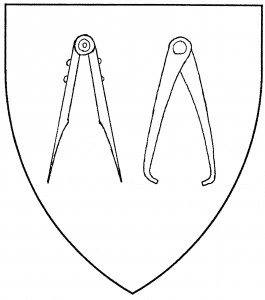A compass is a mathematical instrument used for drawing arcs of circles. It consists of two straight pointed legs joined by a pivot at one end. The compass is a period charge, found in the arms of the Worshipful Company of Carpenters, 1466 [Bromley & Child 40]; it’s sometimes termed a “pair of compasses” in modern parlance.
The compass is sometimes drawn with a semi-circular scale for measuring its spread; this is a period form, found in the arms of de Capitanis de Sesto, mid-15th C. [Triv 98], and of Petzlinger, 1605 [Siebmacher 98]. This form may be blazoned a “divider” or a “drawing compass” in the Society.
Very similar is the “pair of calipers”, an engineering instrument for measuring thicknesses and diameters; it differs from the compass only in the tips of its points, which are curved inward (or sometimes outward).
The distinction between the various forms of compass is not rigidly observed in Society heraldry; certainly there is no heraldic difference between them. The defaults for compasses and calipers are the same: points to base, and slightly spread.
The Ministry of Sciences bears: Per pale Or and argent, a pair of calipers sable.
The Award of the Compass, of Northshield, bears: A pair of compasses Or.
Arthur Lemner of Wesley bears: Azure, in pale a drawing compass and a two-spouted oil lamp argent, enflamed Or.
